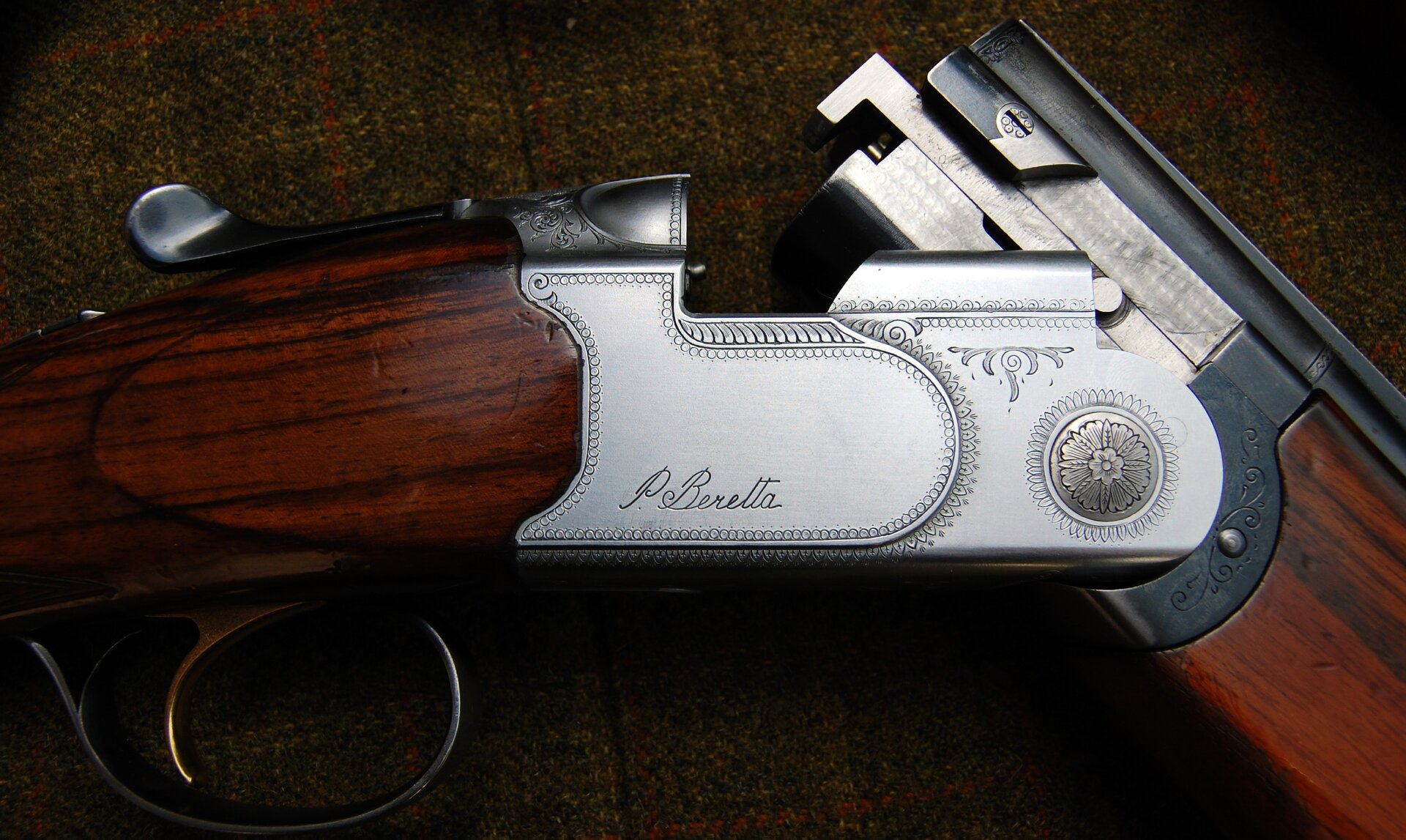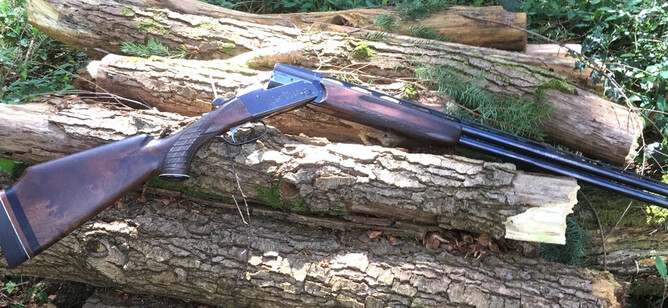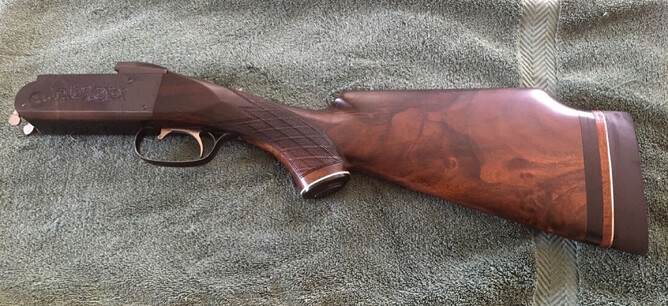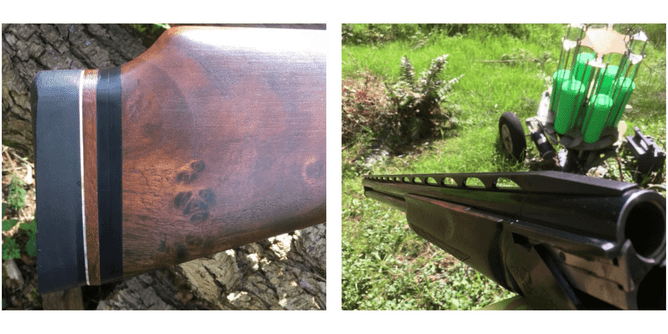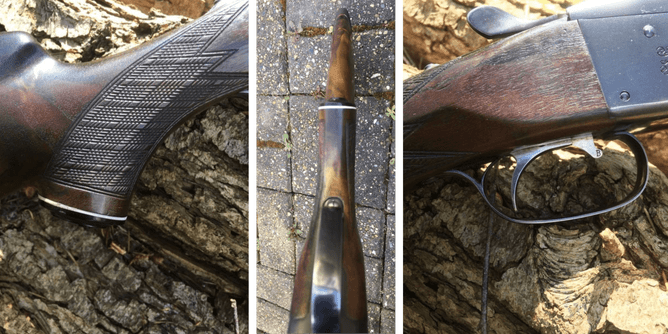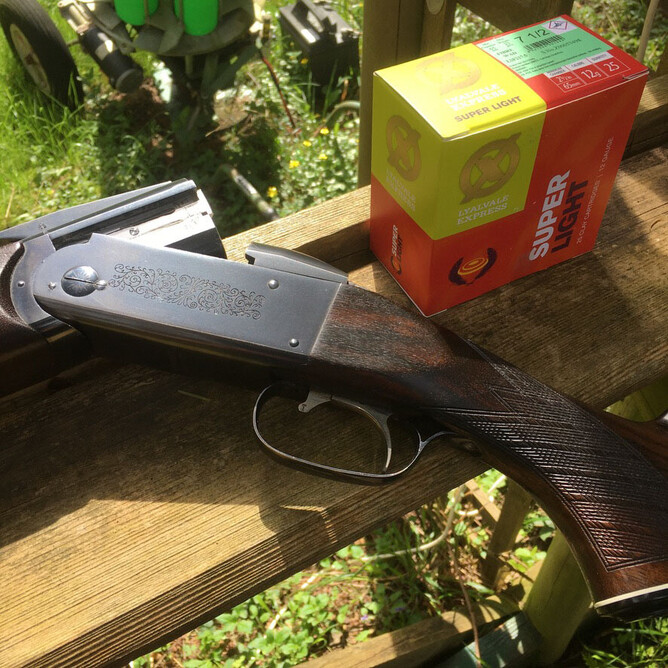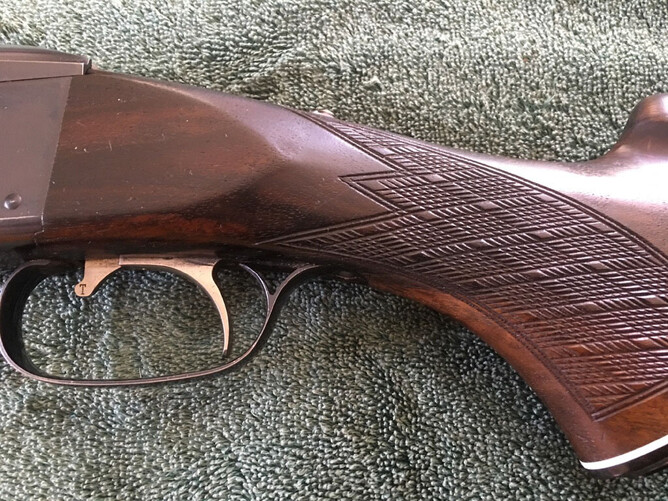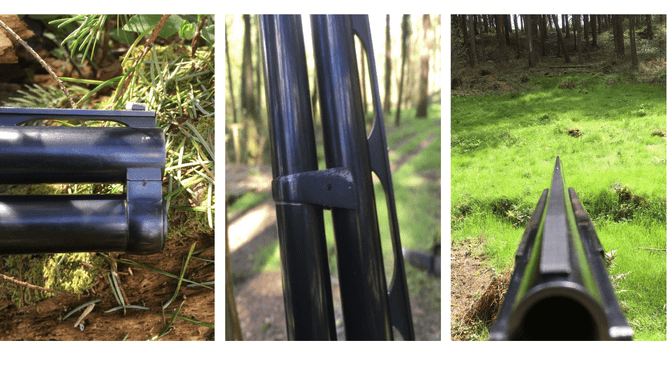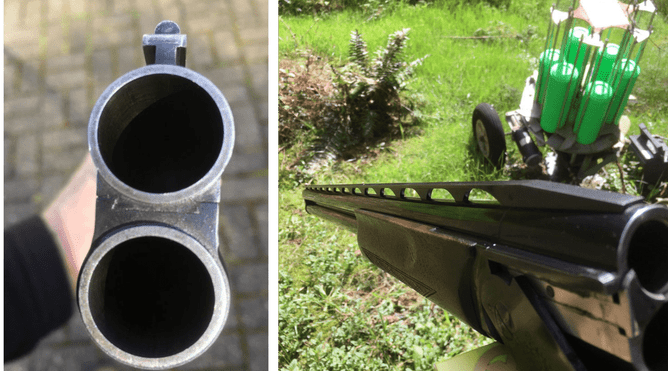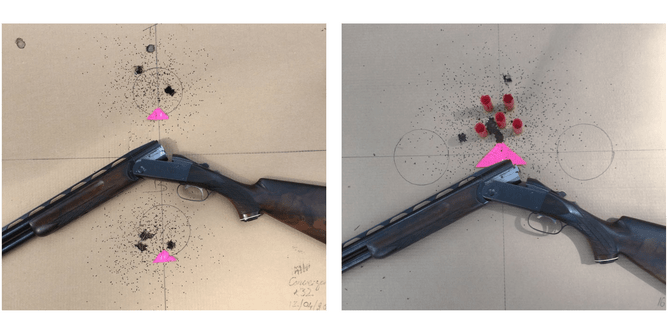The Kreighoff Model 32 shouldn’t have been. The Remington Model 32, the gun that inspired the Kreighoff, as it came to its own hesitant end, should have ended the line. The Remington belonged to a different age — an age when quality of function beat cost of production every time.
The commercial rules of gun-making are brutal. These rules should have strangled Kreighoff’s Model 32 at the concept stage. So, just how did the Kreighoff win through? How was this gun able not only to survive but spectacularly thrive?
Today the Kreighoff Model 32’s legacy is secured by the K-80. But is there something yet to be found within the 32 that will still serve today’s sporting shooter well? If you can find them intact, this gun offers clever opportunity in repurposing a quality shotgun to the high-octane demands of modern sporting shooting.
What do we have?
Let’s have a look at this Kreighoff Model 32 currently presented at Raker Ltd., …
Made as a Trap gun; (# 8455) dated 1972. Indeed, Kreighoff guns of this era were made as either dedicated Trap or Skeet guns. They’ve been around a good while, so stocks are often modified, and this point is key when repurposing.
Unless previous modifications suit you very well – and, let’s face it, that’s usually too much to hope for! – it’s better to start out with as near original as possible.
Mods to LOP are usually simple to fix, but combs are another story. As we shall see, the pitched sighting-rib is a critical element of this gun’s function and designed to work with higher combs. It is important that combs have not been taken too far.
The comb work on this Kreighoff Model 32 is original and that is a significant plus. This means it is possible to fine tune in terms of fitting requirements as needs be.
At a push, even if combs have been heavily modified, not all is immediately lost. The fitting of an adjustable comb unit to the stock or a wood-piece inlay will get things back on track.
So, the practically parallel Comb on this gun is intact as the maker first intended. You will note that there has been adjustment – actually, in all probability several adjustments – made to the 32’s LOP over the years. Also, to the pitch angle of the stock. No matter, as these are the easiest stock adjustments to change.
Grip and Trigger
Quality gunmakers pay a good deal of attention to ‘control surfaces’ on a shotgun. These are all points where the user contacts the gun: FACE – SHOULDER – BACK-HAND – LEADING-HAND.
The rear-hand grip is a critical contact point. The grip offers the hand control, the trigger within easy reach. The trigger is the ‘go switch’ — it alone captures the very moment of the user’s expectation. Grip and trigger have to be right.
The pistol is a true half-grip, not the chunkier and fuller three-quarter pattern that you see on many of the Sporting/Trap hybrid stocks today. The angle of the grip (‘rake’) on the Model 32 ‘opens’ and with no re-curve to the grip-cap.
Such features were common on stocks dedicated to trap shooting at the time. Fashions change, of course they do, but actually the Kreighoff 32’s grip as presented here is a true reflection of patterns favoured on sporting stocks today. An added bonus in our repurposing mission.
The sides of the grip are straight, tapering up slightly, without any palm-swell. This is a positive and is an aid to active (off-the-shoulder) mounting if that’s your thing.
The rear-hand actually tightens to a grip leading up to a shot, an instinctive and natural part of firing. Thin grips offer too little, thicker grips often too much; the grip on this 32 is nicely proportioned.
It might also be seen that a more flexible rear hand position is a plus point when mounting. This allows the hand/wrist to lift and shift responsively, the stock settling into the shoulder, grip firming, finger to trigger — a shot imminent.
Sitting within its generously sized guard, the trigger – which is distinctively straight, or at least minimally curved – falls well to the finger. No trigger guard/shape has been better designed for a completely gloved shooting hand before or since!
Sighting Rib
The sighting rib on this Model 32 (a ‘Vandalia’ type) holds within it the potential to re-purpose this shotgun to sporting clays. It is the nature of this renowned sighting rib feature that will unlock the shooting advantage of this shotgun.
Other barrel ‘furniture’ is more typically Kreighoff — barrel hangers at muzzle and mid-tube; characteristically minus middle joining-rib. Although the concept and function of these features owe much to the Kreighoff’s Remington forebear.
Barrels
How barrels perform individually as well as together represent the heart of any shotgun. The most expensive shotgun in the world is only as good as the patterns it consistently throws.
Kreighoff had to get the Model 32 right. Let’s now see how right Kreighoff got this gun.
We must evaluate also whether this gun can stand its own alongside more modern guns; as long as the fundamentals remain sound, age is normally no disadvantage –often conferring quality in terms of materials and finish: and we might state that confidently.
Barrel Convergence
Barrel convergence is top-end and, very importantly, we have no separation of the barrel POIs into the figure-8 pattern found on a good many Trap-guns.
Under normal circumstances convergence plates are taken x3 as a matter of course. In this instance the convergence results were so positive that I couldn’t help adapting the last (convergence) plate into a 16-yard fit-assessment plate.
This gun had shot well for me throughout testing, so I wanted to see what it looked like — couldn’t resist! The apex of the tri-angular marker is the POA on the FIT-Plate — and I’m just going to leave it there without comment … (yes, it’s that good!)
Barrel Measurements
Note super long, super smooth chamber forcing cones.
Long, finely graduated choke forcing cones (conical).
True bores ‘tighter’ than most modern barrels (about 18.3mm) — in keeping with barrel-boring practice at the time: stabilising pressures, efficient wad-to-barrel sealing, straightening wads, etc.
All boring features geared toward consistency in barrel performance and contemporaneous to the period of manufacture.
Patterning
Test Cartridge: Hull CompX 65mm 28g - 7½ - (compressed) Fibre (plug-type) wad.
To make the broadest appraisal here we might borrow a ‘stepping in’ method from traditional barrel regulation practice.
Patterns are assessed at 40 yards as a matter of convention, but regulators would start close-in before finishing at distance.
Working closer the experienced eye can gain much about how a pattern from a given cartridge-barrel-choke combination forms.
Circularity, even-ness, minimised ‘strip’ (damaged pellets), lack of centre gaps, no fringe-‘flaring’ are all criteria linked to pattern quality.
The pattern here throws a 63% choke from its ‘half-choke’ boring. Pattern Core is dense enough to extend functional range (a favoured boring trick for Trap barrels).
To Conclude
Solid and reliable, this classic Kreighoff Model 32 is capable of top-end work. Chokes and borings are well suited to repurposing to sporting use.
The sighting-rib is the key to this gun, coupled with an intact stock. High ribs are suited to those demonstrating visual shooting techniques; with lead pictures progressively built, formed accurately; visually ‘cued’ to the shot.
Higher head position keeps the eye(s) above disturbance from the barrel plane or the immediate target pick-up position. The gun shoots functionally flat.
Spares and upgrades are available through Kreighoff-UK. Lastly, an excellent way to experience Kreighoff potential without having to sell property or non-essential body parts! So, everything to like and much to gain.
For a walk-through the detail contact Catie at Raker (01428) 708102
